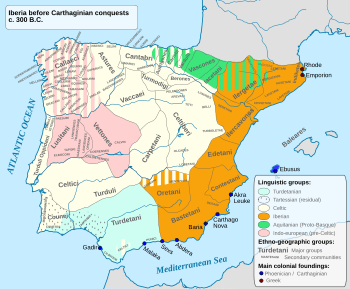Caristii facts for kids
The Caristii were an ancient tribe. They lived in the northern part of what is now Spain. This area includes the historical regions of Biscay and Álava. These places are part of the Basque Country today. The Caristii lived there before the Romans arrived.
Contents
Who Were the Caristii?
The land where the Caristii lived matches the area where the Biscayan dialect of the Basque language is spoken. However, historians are not sure about their exact origins. Some think the Caristii were related to the Aquitanians. These people were also linked to the Vascones. Others believe the Caristii were Celts. They might have been related to tribes like the Cantabri and Celtiberians. If they were Celts, they might have later adopted the Basque language and culture. This process is called Basquisation.
Caristii in History
The Caristii are first mentioned in Roman writings. Pliny the Elder, a Roman writer, called them Carietes. He said they lived in the inner parts of the Basque Country. This is the southern part of the region today. Another Roman writer, Ptolemy, placed them differently. He said they lived between the Deba and Nervión rivers. This area is now in the provinces of Biscay and Gipuzkoa. Their land was shaped like a triangle. It reached the city of Vitoria in the south.
Caristii's Neighbors and Cities
The Caristii shared borders with other tribes. The Varduli were to their east. The Cantabri were to their west. The Autrigones were to their southwest.
They had several important cities. Tullica was likely Tuyo, near the Zadorra river. Suessatio might have been present-day Arkaia. Veleia or Velegia was another key city. These last two were close to the Roman road that went from Bordeaux to Astorga. Another city was Vesperies, located on the Atlantic coast.
The names of their cities often sound like Celtic words. For example, Tullica comes from "Tullo," meaning valley. Suessatio means "well settled." This is interesting because no city names related to the Aquitanian or Proto-Basque have been found. This supports the idea that the Caristii might have been Celts. They could have later adopted the Basque language.
What Happened to the Caristii?
The Caristii are not mentioned much after the Roman times. In the Early Middle Ages, new regions like Biscay and Alava appeared in their place. Some historians believe the Caristii, Autrigones, and Varduli tribes worked together. They might have even formed a political group. Later, these tribes were sometimes all called Varduli.
This could explain why the Caristii and Autrigones seemed to disappear. They were grouped with the Varduli. This union of tribes eventually led to the creation of the County of Bardulia. This county later became part of the Crown of Castile.
See also
 In Spanish: Caristios para niños
In Spanish: Caristios para niños
- Pre-Roman peoples of the Iberian Peninsula
- Varduli
- Autrigones
- Cantabri
- Vascones
- Origin of the Basques


